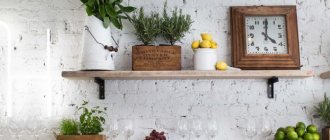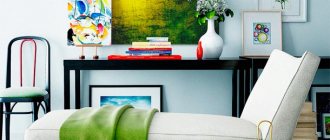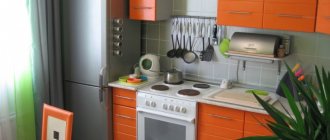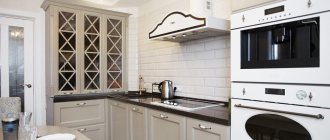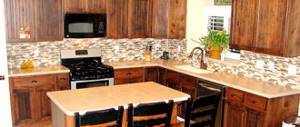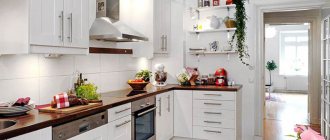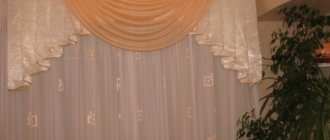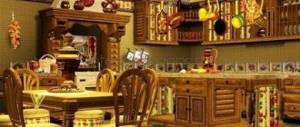An apron is a very common and practically unchanged piece of clothing from ancient times to the present day. There were aprons for men and women. Their roles were different - ceremonial, working, status, decorative. Nowadays, housewives do not often use an apron, finding a more modern alternative. But in vain! This is a very comfortable and cute piece of clothing. Moreover, even a schoolgirl can make an apron.
The technology of sewing an apron and its patterns is studied already in the 5th grade during labor lessons. This easy-to-make item is the perfect choice for learning sewing skills. In this article we will look at how to construct an apron drawing, as well as sewing several models.
Basic models of aprons
The school textbook “Technology Grade 5” includes sections on the technology of processing wood, metal, artificial materials, and child-friendly information about rational housekeeping technology. Many of these jobs require special clothing in the form of a children's apron. That is why the ability to sew an apron for a girl is very important.
All apron models are divided into two groups - an apron with a bib and an apron without a bib. Options for models with a bib, in turn, can be divided according to cutting technology into cut-off at the waist and one-piece.
The simplest types of aprons offered for making in labor lessons are shown in the following pictures. For each apron, the construction of the drawing is made on 1⁄2 of the full pattern. This was not done by accident. This is how you should mark out the details of the apron by applying half of the pattern to the fold of the fabric. This will ensure complete symmetry of the product.
If the girl has already sewn a simple apron model, then she can decorate the apron with various details. Several interesting options are shown in the following figure.
Based on simple basic patterns, you can simulate an apron pattern by flaring or changing the bottom cut line. The schematic construction of the drawing is shown in the figure below.
Each hand-sewn apron is sure to be interesting and unique. A novice craftswoman can select jewelry and choose a style at her own discretion.
Next, let's look at sewing an apron step by step.
Drawing on the panel
Image technology:
- The design is applied to the vinyl film using the popular large-format photo printing or rolling method;
- direct printing on the base;
- matting the glass surface;
- artistic painting with paints.
Decorating a glass apron:
Single-color panels lacobel method . On the reverse side they draw a picture, make a gradient pattern or mix varnish paints, making stains.
When using varnish, first a film of matte translucent varnish is applied to the glass, with which there is no shine and the contours will become blurred. They paint on the film with colors. Little dirt is visible on such panels.
With stencil application . The resulting panels are identical.
The image is applied using stereo printing using special UV ink. The drawing looks three-dimensional, visually pushing the walls apart.
Modern photo printing allows the application of designs of the customer’s choosing on panels and surfaces of facades.
More: Fashionable and original ideas for curtains for the kitchen
The mirror surface is obtained using plain silver paint, which is applied to the reverse side.
An inexpensive method with adhesive-based polymer film
A tinting or stained glass film is glued to the back of the glass. A plain surface or with an image, matte or transparent, with convex relief patterns or a 3D effect .
With this method, it is worth making sure that there is not even a small gap between the panel and the wall.
Apron for work
The apron pattern for a technology lesson in 5th grade is very simple. How to build the main part is shown in the drawing below. The belt ties and straps need to be made according to your own measurements.
To sew an apron for a schoolchild you need to prepare:
- fabric 0.6 by 0.6 m;
- bias tape to match the color of the main fabric - 3 m;
- Velcro tape for the belt;
- threads, sewing tools.
Description of tailoring
Mark the details on the fabric. An example of the layout is shown in the following figure. In addition to the apron, it also shows details of arm ruffles and scarves.
We cut out all the details (except for the belt and straps) without seam allowances, since we will process the cuts with bias tape.
We process the sections of the main part with bias tape.
We cut out the blank for the belt with an allowance of 1 cm in width. Fold the strip in half with the wrong side inward, and sew along three sides. Turn it inside out and iron it. Fold the free edge allowances inward. The dimensions of the finished belt are 2.5 by 16 cm. We fix the belt on the main part with pins and attach it. Sew Velcro tape onto both parts of the belt.
On the pocket blank, turn the top cut 5 mm to the wrong side and stitch. Then we make another turn at 25 mm, stitch along the edge of the fold.
The remaining sections of the pocket should be finished with bias tape. Place the pocket on the main piece, baste or secure with pins. Machine stitch the pocket. Make triangular tacks at the corners. Sew a dividing seam in the center of the pocket.
Finally, remove the basting threads and iron the product.
A simple apron pattern for a child 5-7 years old
For a girl, the opportunity to cook in the kitchen with her mother is not just work, but a kind of status acquisition. She becomes a real adult hostess. And, of course, such work requires appropriate clothing. We invite you to sew a simple but cute apron for your little helper.
For sewing you will need:
- dense fabric of natural composition, linen, cotton are suitable - 0.4 by 0.43 m;
- oilcloth of the same size - optional;
- strip of lace (optional) – 19 cm;
- bias binding – 0.6 m; 0.75 m; 0.75 m; 0.16 m or strips of fabric of similar length, 3 cm wide;
- threads, sewing tools.
Description
The pattern must be constructed according to the proposed drawing.
If desired, you can make a second layer of oilcloth for the apron. In this case, we cut out the second part, put them together (oilcloth at the bottom) and stitch. Next we work as if we were working on one piece.
Using a basting stitch, sew bias tape along three sides of the apron. Attach and, if necessary, trim off excess trim.
If a strip of fabric is used instead of a finished binding, then we make two counter folds on it and iron it.
We also trim the top edge with bias tape or a strip of fabric. If desired, sew in a lace ribbon.
We process the cuts on the sides of the apron, deciding on the required length of the ties. First we fix the parts with pins, then stitch them.
Repeat for the second side.
We hem the open edges of the trims by hand or by machine, tucking them inward.
Iron the finished product.
What kind of glass is used in the production of kitchen skins?
The performance properties of a glass kitchen splashback are largely determined by the type of glass from which it is made.
For the production of skinals the following is used:
- stalinit - tempered glass;
- triplex;
- plexiglass;
- polycarbonate
Stalinite is silicate glass that has been subjected to special heat treatment (high heating followed by rapid cooling), due to which it becomes resistant to mechanical damage and temperature changes.
A stalinite apron can be installed even near gas burners, and the service life of the product exceeds 20 years.
If, however, the skinali breaks (although this requires a lot of effort), then the fragments will have blunt edges that cannot be injured.
The only disadvantage of a stalinite apron is its high cost. But this is only at first glance - the impressive service life will allow the product to quickly pay for itself.
Triplex is a multilayer material that consists of several alternating layers - silicate or tempered glass and polymer film.
The latter gives the product increased safety - if the glass is damaged, the film coating holds the fragments on itself, preventing them from scattering to the sides and causing injury.
The polymer layer also performs a decorative function, because it is easier to apply a design on it than on the glass itself.
Plexiglas is an acrylic-based material. It cannot be broken, it is light and inexpensive. However, it is rarely used for the production of skinals - plexiglass is not scratch-resistant, deforms when overheated and requires gentle care.
Polycarbonate is a material similar in properties to acrylic glass. According to its chemical composition, it belongs to plastic, but due to its shine it is often identified with glass. It wears out just as quickly as acrylic.
Of course, the best option for the skin is tempered glass, and if the budget is limited, then triplex.
Typical dimensions of a glass apron are:
- width - from 0.6 to 4 m;
- height - from 40 to 100 cm;
- thickness - from 4 to - 10 mm.
If you want a solid glass apron, then it is advisable that its length does not exceed 2-2.5 meters. A sheet of glass that is too long is difficult to transport and deliver to the installation site without damaging it.
Apron made from old jeans
If your son needs an apron for labor lessons, we suggest sewing it yourself from old jeans. This solution has several advantages. Firstly, denim fabric is quite durable, which is important given the purpose of the apron. Secondly, sewing such an apron is simple and quick, since there is absolutely no need to create a drawing. Thirdly, in the end you will receive a unique product, different from boring store-bought analogues. Fourthly, you will save your family budget.
Description
Let's look at making an apron step by step. First, let's cut off the belt from the front. We do this carefully, without damaging the straps.
Gallery
DIY glass apron for the kitchen - see here.
Did you like the article? Subscribe to our Yandex.Zen channel
Great article 0
Apron with applique
Child's age: 3-4 years.
For sewing you need to prepare:
- plain, wrinkle-resistant fabric for the main part;
- checkered fabric for facing;
- white fabric, not “loose” - for appliqué;
- black floss threads;
- sewing supplies.
Description
First you need to make a template for the application. The finished diagram is shown below. Draw the drawing from the monitor or print it to the required scale.
We don't need to make an apron pattern. We will mark directly on the fabric. To do this we need two measurements. We measure the length of the product from the shoulders to the desired level and the distance between the shoulders. For example, it turned out 60 cm and 25 cm.
We build a rectangle according to these measurements, set aside 6 cm on each side to the center, cut out the armhole.
Using the main part as a template, we mark the facing.
This is what happened.
We sew them on three sides.
We place a facing on the wrong side of the main part. We place ties between them as shown in the photo. Baste and stitch at a distance of 1 cm from the cuts.
We cut allowances along the bend lines.
Turn the facing right side out, secure it with a basting stitch at a distance of 1 cm from the edge, and iron it.
The wrong side turns out neat.
We turn the edges of the facing inward, leaving a width of 25 mm. Then we baste.
Sew with a zigzag stitch.
Using carbon paper, transfer the design to the fabric and cut out along the contour.
we sew, turn, iron.
We embroider the face of a hare. We baste the applique by inserting the ears. Sew on the applique with decorative stitches.
Place a stitch at the bend of the eyelet. The apron is ready!
A kitchen apron is a traditional kitchen garment. It is this that protects against various dirt and greasy stains. If in the past it served only a protective function for clothing, now an apron can be a decoration for the housewife. After all, the creative delights and variety of decorative elements are so wide that they allow you to create an exclusive item. In this article we will look at patterns.
Everything you need to know about glass splashbacks
According to modern designers, glass and photo printing are an ideal combination from both a practical and aesthetic point of view. The new technology of applying patterns to durable glass allows every housewife to make her kitchen more convenient, more beautiful and more unusual.
Glass panels with a pattern will add zest and originality to the decor.
First, let's make it clear: the “kitchen apron” is the area located between a row of wall cabinets and the countertop. And it needs decorative design that will not only complement the interior of the kitchen, but also protect the wall from dirt, water, and grease. Glass panels are ideal for both of these tasks.
Skinals perform not only a decorative function, but also protect the wall from dirt
Main advantages
A decorative apron for the kitchen based on durable glass (skinali) has become one of the most popular options for cladding the work area. There are several reasons for this, and we will talk about all of them in this section.
You can choose the designs for the kitchen apron yourself, the main thing is that the photo is of good resolution
The main advantages of the skin include:
- Hygiene . A perfectly smooth surface and the absence of joints prevent the accumulation of dirt, the appearance of fungus or mold on the coating.
- Low maintenance requirements . Cleaning the skin with your own hands will not cause you absolutely any problems. They can be washed with almost any cleaning products.
It is not difficult to wash skinali - they easily tolerate any cleaning agents
- Durability . You don’t have to be afraid of accidentally catching such an apron and breaking it. It's made from incredibly durable tempered glass, so it won't be damaged this way.
- Moisture and heat resistance . Skinali are not afraid of either high humidity or temperature changes. So they can effectively protect the wall of the work area from damage.
Temperature changes and high humidity, which are typical for the kitchen, are not affected by tempered glass
- A wide range of . You can choose absolutely any design for your kitchen apron – from abstraction to a panoramic image. If you wish, you can even order skins with a family photo or favorite painting.
- Easy installation . Installing glass panels yourself is not difficult; you don’t even need to specially prepare the wall surface.
The instructions for installing a glass apron are simple; even a beginner can complete the task in less than an hour
Types of glass aprons
An apron with a beautiful and at the same time high-quality image can be made in three ways. Let's look at each of them in more detail.
The most popular are three options for applying a pattern to glass:
- UV printing . It is applied with special ink, which polymerizes under the influence of ultraviolet radiation, takes on a solid state and forms a durable film. It then protects the drawing from any external influences (sun, moisture, mechanical damage).
A special film protects the design from fading
- Vinyl film . In this case, the printed pattern is rolled onto the inner surface of the glass. Thus, the image is reliably protected from moisture and temperature changes. The price of such a product is lower than that of UV printing, but its service life is shorter.
Vinyl film is cheaper than UV printing, but inferior to it in terms of service life
- Double-layer glass with image . The design is placed between two layers of tempered glass; this design is particularly strong and durable. But it also has one drawback: if you want to change the image, you will have to disassemble the entire apron and then assemble it again.
To change the pattern in a two-layer apron, you will have to completely disassemble the structure
Types of aprons
There are two main types - with and without a bib (apron). The apron is a rectangular piece with a sewn belt. The apron consists of two main parts - the hem and the bib. They are originally sewn as a single unit. Straps and a belt, pockets are sewn to it. If desired, you can decorate with applique, ribbons, braid, lace, buttons and other sewing accessories.
The apron in the kitchen gets dirty and requires frequent washing. Not all housewives are ready to wash their chic attribute until it looks unsightly. In this case, you can have one simpler one - for work, and another, spectacular one - for meeting guests or for a modest bachelorette party in the kitchen.
And aprons for the whole family will help create a family tradition of joint creativity in the kitchen.
Fabric selection
When choosing the color of a future product, take into account several tips:
- On variegated, multi-colored fabric, spots are less noticeable.
- On a plain color, especially a light one, the spots are more visible. Dark ones are more practical in this regard. Any plain color can be advantageously decorated with another bright fabric, braid, applique, or sewing elements.
- An interesting solution would be a product made in the same color scheme as the design or textiles of the kitchen.
- Choose color and style according to your own preferences.
- The coloring of the fabric must be permanent and not be washed out during washing or stain clothing.
The main thing when choosing will be the preferences of the hostess.
Catalog of images for the skin
Many companies producing glass aprons offer their own catalogs, where you can see the most popular and sought-after images for the kitchen.
Absolutely any image or inscription can be applied to the skinali
Note! There are also unique design pictures that are developed by design professionals. These options look incredibly beautiful and expensive.
For each kitchen you can choose the perfect glass splashback; the main thing is to take into account the features of the room, the decoration of the walls and ceiling, the color scheme and style of the set, and the overall design picture.
A beautiful image on a kitchen apron can radically change the interior of a room
The scenes applied to glass have many options, and most importantly, you have the opportunity to choose your own picture
In the catalogs of pictures for glass kitchen aprons you can find the following topics:
- Designer skins with unusual, non-standard images.
- Floral and plant prints with colorful pictures of flora.
- Abstract pictures in different colors.
- Imitating the texture of various masonry or stone surfaces.
- Unusual textures, for example, brick, fabric, wood, mosaic.
- Images of fruits and vegetables, still lifes.
- Cityscapes and landmarks.
- Pictures of food, drinks and dishes.
- Seascapes and views.
- Architectural monuments and architectural elements.
- Landscapes of beautiful nature.
- Images of animals and birds.
- Pictures in macro style.
- 3D options.
- Art pictures.
- Plain or monochrome.
The most popular are 3D and macro themes, as aprons in this design really amaze the imagination.
Styles
- straight, different length and width hem;
- lower part gathered at the waist;
- with rounded or flared edges at the bottom;
- with pockets in the center of the apron, on the sides or at the bottom;
- hem based on a semicircle;
- with flounces, ruffles;
- with interesting yokes or gathered bodice;
- apron-sundress;
- asymmetrical cut.
- from a colored scarf;
- men's shirts;
- denim trousers;
- old dress;
- knitted, made using patchwork technique;
- decorated with matching or contrasting fabric, interesting sewing elements, photo printing;
- made in different stylistic directions (from simple rustic to sophisticated classics).
It is better for novice craftswomen to choose simple straight options, both with and without breasts. And decorate with decor.
The brilliance and sophistication of glass on a kitchen apron
Compared to plastic, glass is a more expensive material, but reliable. Panels are made from plexiglass (another name is acrylic). This kitchen apron does not deform from constant exposure to high temperatures or moisture. The design will also last a long time due to the fact that the printing is applied with special inks.
Such panels do not contain harmful substances and do not fade. Another feature of glass panels lies in the design itself. It will appear voluminous and colorful. Why is it worth choosing this type of “protection” for kitchen walls?
- The surface of the glass is absolutely smooth and does not contain pores. This means it will be easy to remove grease and dirt. It is enough to wipe the panel with a sponge or damp cloth. Do not use abrasive powders to avoid scratching the delicate glass.
- Photo printing itself will hide all the shortcomings of acrylic - traces of water drops, steam and stains. If you don’t have time to polish your glass kitchen backsplash, don’t worry: the design will look just as colorful. In the following photos, look at examples of glass splashbacks in different colors.
- It will be difficult to break or damage glass , since the material is highly durable. He is not afraid of being hit by a saucepan or kettle.
Of course, the main advantage of such a product with photo printing is the variety of pictures and drawings. You can choose a kitchen apron with images of bottles that seem to “hover” above the countertop, photos from the family archive or fantastic pictures in the form of animals, dishes or landscapes.
Making an apron pattern
Constructing a pattern with a bib
- Measure the circumference of the hips, the length of the product from the waist to the bottom, the height of the chest part from the waist and the width.
- The paper is folded in half. A rectangle is drawn, the side of which is equal to the length of the product, and the lower or upper side is equal to the fourth part of the circumference of the hips.
- The chest part is performed in the same way. Fold the paper in half and draw a rectangle. The side side is equal to the height of the part, and the bottom or top is half the width of the chest part. The sides may have smooth concave cuts.
- The details are cut out and copied onto the fabric. In this case, the threads on the patterns must match, the pattern is directed upward. Do not forget about seam allowances, 1.5–2 cm on each side. Cut out.
- For the belt, you need to cut 2 pieces 1.5 meters long, 5 cm wide, for neck straps - 2 strips 50–60 cm long, 9 cm wide.
How to sew a beautiful kitchen apron with your own hands
You can sew a stylish, beautiful apron not only by cutting it out of new fabric, but also from old things. They haven't been worn for a long time, but their appearance is still attractive.
Apron made from denim trousers or shorts
Style : straight and ruffled, with appliqué on the bib.
Materials : old jeans, bright multi-colored fabric for decoration.
- For the hem, cut out the front part of the top of the trousers without side seams.
- Ryusha. Strips 8 cm wide are cut out of colored fabric along the bias. Stitched. The length of the strip should be 1.5 times longer than the edge being trimmed. The gathered ruffle is sewn on.
- A pattern is prepared for the top part: a sheet of A-4 format is folded in half and the desired shape is cut out.
- The back of the trousers is ripped open. A bib is cut out from a part with a pocket (the pocket should be in the center). The lower part of the part is increased by 1.5 cm for the seam.
- Make a bias tape 3 cm wide and cover the open sections of the chest. If desired, sew a matching applique onto the pocket.
- Finished parts are sewn together
- Ties made from strips are sewn onto the belt and onto the upper part. Their length is 55-60 cm.
Apron from a men's shirt
Materials : shirt, bias tape, buttons, ribbon in a color that matches the shirt.
Style : straight, one-piece.
Manufacturing
- Lay out the buttoned shirt evenly. Place a dot on the shoulder seam, 3 cm away from the point where the shoulder seam meets the neckline. Place the next point on the side seam, 7–10 cm away from the bottom point of the armhole. Connect these points. Repeat the same on the other side of the shirt.
- Cut the pattern along the side seams, along the drawn lines and behind the collar, leaving a margin of 2 cm.
- Finish all edges with bias tape or hem stitch.
- Sew buttons, ribbons on the belt, straps on the neck, decorate the pocket with ribbon.
Festive apron
Material : 1.5 meters of cotton fabric with a bright pattern, matching lace.
Style : based on a semicircle with a chest with ties, a bow belt.
Manufacturing
- Skirt. Measure your waist circumference.
- Fold the fabric in half, right side inward. Measure half the circumference in the corner. Draw a smooth line.
- Place marks from the line at a distance of 45 cm, connect with a smooth line.
- Cut out. Round the bottom corners of the hem.
- Finish the hem with lace.
- Breast. Cut a rectangle 35 cm long and 25 cm wide. Round off the side cuts by cutting inwards. Trim three sides with lace.
- Belt. Cut two strips 1.5 meters long and 5 cm wide. Connect both parts of the belt with the bottom of the product and the bib.
- Ties. Cut out two strips 50–60 cm long and 9 cm wide. Attach the sewn straps to the top of the product.
Shabby chic apron
These are light, elegant aprons with lace trim and cute flowers. They are made of linen and cotton materials. Pastel shades (white, gray, beige) are more common in the style. For a bright accent use pink or blue.
Straight-cut products are taken as a basis and decorated with ruffles, lace, appliqué, cross stitch, satin stitch, and beads.
What types of skins are there?
Any type of skin can be equipped with built-in LED lighting
Similar to ordinary glass
This option resembles standard, transparent or frosted glass without frills, patterns or pictures. The transparent option allows you not to hide the beautiful wallpaper behind the apron, but rather demonstrates it, since it is, in fact, a protective screen from dirt, moisture or high temperatures.
You can simply cover wallpaper or a painted wall with transparent glass so as not to overload the interior with dissimilar surfaces
With a transparent apron, the kitchen will remain in the form in which you originally intended it, which is sometimes the best solution. Additionally, the transparent surface gives an original effect to the design, as it looks fresh and original.
The decor of the skinali can be bright or discreet, it all depends on your preferences
Matte options look interesting and are suitable as a universal design option for any kitchen.
In addition to frosted and transparent glass, there are kitchen skins with a textured or embossed surface. A more intricate design is suitable for creating an exclusive interior.
With photo printing
Luxurious photo aprons for the kitchen are a real trend in interior design today. Detailed, multi-color, bright and rich printing in the kitchen interior looks new and ultra-modern.
Panels with photo printing are 30–50% more expensive or even twice as expensive if stereo printing is used
Skins with photo printing have many advantages:
- durability;
- mega strength;
- resistance to physical influences;
- immunity to high and low temperatures;
- effectiveness.
They, like other glass aprons, are easy to care for, as they are unpretentious in everyday life.
When ordering skins with photo printing, you can choose the appropriate image yourself
The durability of the print is explained by a special technology in which the design is applied with ultraviolet light to the reverse side of the surface so that it appears to appear through glass. The transparent outer layer is almost invisible, which creates an amazing skinny effect - a beautiful photographic picture on glass.
Note! Photo printing can be on any topic; three-dimensional options, in which the drawing takes on a three-dimensional form, are incredibly in demand. 3D skins have a higher price than those with ordinary photo printing.
Made from painted glass
An apron made of painted glass looks stylish and unusual, as it has a glossy surface in a rich or neutral color. To achieve this effect, paint or varnish is applied to the back of the glass panel and, when visible through the transparent layer, the color becomes glossy and shiny.
A plain apron is a universal solution when you can’t decide on a suitable picture
This version of the apron is durable, reliable and harmless to health. In addition, it retains its original appearance for many years. The painted layer, hidden behind the glass, does not fade in the sun and does not fade over time.
Plain painted glass panels are an ideal choice for a minimalist or any other modern kitchen.
White skins with a matte surface in a high-tech kitchen
Covered with film
A budget option for skinali is glass panels covered with colored or printed vinyl film. This option has disadvantages, such as sensitivity to temperature changes, lack of fire resistance and susceptibility to physical influences.
It is important to install skins with film correctly so that the polymer coating is less exposed to steam and moisture
Three-layer glass
An expensive glass kitchen apron is made of several layers of material, between which a film with an image is placed. Such a panel cannot be broken, but cracks may appear on it. Since the manufacture of such a panel requires a large amount of raw material, the price of such an apron will be quite high.
An apron made of three-layer glass is an almost ideal choice and a worthy alternative to ceramic tiles
Triplex is safe, durable and heat-resistant. Cons – heavier, more expensive and less transparent compared to tempered glass
Mirror skins
A luxurious mirrored apron not only visually expands the boundaries of the room, but also gives the room an exclusive look. An exquisite painting or any design can be applied to the mirror surface of tempered glass to make the stylish solution look even more advantageous.
Mirror skins can visually expand space and change perspective
Children's apron for the kitchen
Stitched in the same style as mom or dad, they don’t have to be the same. They can be combined by color or pattern on the fabric.
For girls, you can choose bright materials with prints - from flowers and nesting dolls to princesses. Discreet aprons can be decorated with decor: lace, bows, embroidery, fabric brooches.
For older boys, choose a straight style in a neutral, strict color. And for kids, on the contrary, with bright applications of cars, animals or stylized cartoon characters.
Apron - types and features ↑
According to their purpose, they can be kitchen, school, or special. Applique, embroidery, facing, and braid can be used as finishing. According to the type of cut they are divided into:
- one-piece (the lower and upper parts are one piece);
- with bib;
- on the belt.
For many nations, the apron is part of the national costume and is decorated with braid, embroidery, ribbons, and hemstitching. A variation of it is the apron; it does not have a bib and is a rectangle of fabric with a belt attached to it.
This is interesting. At first only men wore them. Richly decorated patterns were worn by noble persons; simpler aprons were intended for servants. Over time, this item of clothing changed and even became part of the gymnasium uniform.
In Russia, as in all European countries, an apron is an important part of the national costume
Children's apron - patterns for every taste ↑
Does drawing a drawing seem too long and tedious? We offer three ideas on how to sew an apron easily and simply.
Apron made from patches ↑
- You can create an unusual apron from colorful scraps. Here you don’t need a pattern for a children’s apron; for sewing you need to cut out multi-colored squares from fabric.
- First you need to decide on the size of the components. You can sew a large apron from squares with a side of 10 cm. For a children's apron, smaller patches are suitable (or the same size, but then there will be fewer of them in each row).
- The product consists of 6 rows. First, the squares are sewn into strips, and then the strips into a whole fabric.
- There are 6 squares in the bottom three rows. In each higher row the number of squares decreases, in the topmost there are only 2.
- When all the stripes are sewn, all that remains is to trim the product with braid and sew the ties at the top and sides.
Towel apron ↑
To sew an apron, you can use a kitchen towel with a themed pattern. If the base is sewn from fabric of variegated colors, it is better to make the pockets and trim monochromatic.
“Alterations” from old things ↑
A men's shirt will make an excellent apron for the kitchen. Cut off the sleeves and back and finish the edges with a hem seam. Sew a thin belt at waist level. Now you can go cook dinner!
You can sew it from an old dress or jeans
The applique can be cut out from scraps of fabric, or you can buy a ready-made one in a store for sewing enthusiasts
You can sew it from laminated cotton, in which case you don’t have to waste time removing stubborn stains
An elegant apron sewn using the patchwork technique
Practicality and availability of plastic
One of the most affordable and “amenable” to photo printing materials is plastic. Such an apron, firstly, will perform the main function of protecting the walls, and, secondly, it will be relatively inexpensive.
Printing on plastic is applied directly - this decoration option is more reliable. The picture will retain its color for a long time. Of course, you can reduce the cost of the product and choose a model with photo printing in the form of a polymer film. But there is a risk of getting the design deformed over time. What are the benefits of such plastic aprons?
- They have high moisture resistance. Under the influence of steam, the picture will not fade, and the material itself will retain its properties. The following photos show aprons that are made of plastic and decorated with colorful pictures.
- They are easy to care for. Since the panel is installed in the working part of the kitchen in one continuous piece, there will be no problem such as cleaning the seams. Plastic panels are easy to keep clean - they can be rubbed with a sponge or detergents and the pattern will not lose color.
- Plastic models are lightweight. You can install them yourself. To do this, you don’t need to achieve perfect smoothness of the walls and stock up on a dozen tools. By the way, if you get tired of photo printing, you can replace the kitchen apron and decorate the work area with a new product.
In the following photos you can see what plastic aprons look like in kitchen interiors.
This design technique has been particularly popular lately: printing a pattern on the apron is repeated with the decor of the tabletop or upholstery of chairs in the dining area.
Let's look at the shortcomings. A plastic product may become deformed, especially if the panel is located above the stove area. Also, over time, color printing can fade and become scratched. Why? If you use chemical powders and aggressive cleaning agents, the plastic will lose its beauty.
Video: drawing an apron - an open lesson in 5th grade ↑
Without an accurate pattern, it is impossible to sew a high-quality product. Create a base pattern according to your measurements and you can model a wide variety of styles. Or you can find a suitable version of the finished drawing and cut the product according to it. Now you can be stylish and fashionable even in your own kitchen!
The name “kitchen apron” appeared as an association with the workwear of our housewives. An apron for a clean housewife protects her clothes from stains and splashes of grease. .
Standard apron in the kitchen: determine the height and width from the photo
How often do people complain about a tiny kitchen! But what to do when the opposite happens - the kitchen is too big? Interior design and design is great.
Posted In: All about kitchens
Kitchen aprons are the most necessary and demanding part of the kitchen interior in terms of functionality and practicality. The neatness of the kitchen in the future will depend on what material the apron is made of and its individual characteristics. The main function of the apron is to protect the surface of the walls in the area of work areas as much as possible. Kitchen working areas are divided into three types: • Hot; • Wet; • Most susceptible to contamination. The kitchen apron must meet all the conditions for performing work in these areas. That is, to be heat-resistant, moisture-resistant and easy to care for. Kitchen aprons can be made of various materials. Each of these materials ensures the durability and practicality of the kitchen apron. To understand exactly what kind of apron your kitchen needs, the following information will help. Tile splashbacks There are a great variety of tile offerings. You can easily choose the most appropriate option in terms of color scheme, size of tile units and laying methods. But there is one “but”. In terms of its capabilities, the tile meets only the condition of heat resistance. According to the criterion of resistance to moisture - partially. In terms of ease of care - probably not. The tile itself is a moisture-resistant material. The same cannot be said about the seams between the tiles. If a fungus settles there, it will be very difficult to remove it. For the same reason, tile maintenance becomes more difficult. Kitchen grease, which is embedded in the porous texture of the seams, is difficult to remove using chemical means. Stone aprons A very worthy offer in terms of decorative design. But, as in the previous case, there will be difficulties in care. The relief structure of the stone requires constant careful care; doing it is a rather labor-intensive process. There is one solution - to protect the stone with transparent glass. Such glasses will be discussed below. Glass splashbacks This is the most practical, multifunctional and decorative solution for finishing kitchen walls. Glass splashbacks can be made from raw glass. This is considered a budget offer. Yes, and it does not meet all the requirements. For example, it is not recommended to install such surfaces in the area of a hob or oven. More expensive options are glass panels made of tempered glass, called skinali.
Today this is the best offer due to its features. The advantages of the skinali are the abundance of assortment, endurance to all operating conditions in the kitchen, practicality of care and durability of the kitchen apron. The use of skinali in the design of wall coverings is absolutely safe, despite the fact that by its nature it is still glass. The hardened material from which the apron is made has increased strength and resistance to impacts. It is almost impossible to break it. Even if this happened, the pieces of the broken skin will have rounded edges. To be absolutely sure of safety, the manufacturer has provided a special film that sticks to the surface. Skinali will complement and improve the interior and will delight all guests of your home.
